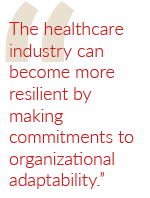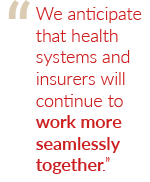The times they are a-changing, particularly in healthcare.
It’s easy to see COVID-19’s vast impact on the consumer experience. Yet change was brewing in healthcare before the pandemic hit our communities. While interoperability mandates driven by CMS’ Final Rule were back-burner ‘ed for a while, they’re still top of mind for healthcare executives. And at the crux of it all, healthcare transformation is picking up momentum, tracking more intently toward the consumer-centered ideal modeled by other industries. Consider it a silver lining.
I recently sat down with two of Perficient’s healthcare thought leaders – Chief Strategist and General Manager of Healthcare, Juliet Silver, and General Manager of Digital Health Solutions, Paul Griffiths – to discuss healthcare’s future. Our conversation will come to you via a series of four weekly blogs.
Q: Covid-19 has sidelined elective procedures and caused many individuals to delay or forego care due to fear of exposure. How can the healthcare industry adapt, so it’s better positioned to withstand future challenges?
Juliet Silver: Providers and health insurers were impacted in different ways by Covid-19 and had to uniquely adapt and respond. Providers and health care systems shifted their care delivery models by moving patients – many of whom were concerned about Covid exposure risk in hospitals – to outpatient facilities where they could undergo elective procedures. To support that influx, those locations optimized by building surgical PPE supplies and enhancing their intake screening procedures.
A recent McKinsey survey anticipates that 40% of physicians are now more likely to refer their patients to nonhospital facilities for procedures and office visits post-Covid. This is important because it builds resilience in health care delivery. 
Also, health care organizations have begun to deploy more telehealth and virtual health solutions to address and care for patients. This is particularly interesting when you look at telehealth adoption, which was below 1% pre-Covid. It soared to more than 50% in early April and now sits at 18% nationally. And consumers are also taking advantage of health care delivery in alternate outlets – for example, receiving primary care at a CVS. I think we’ll continue to see this expansion of options for consumers.
Building financial resilience is another area that health care is putting significant thought behind. When health systems pulled back non-urgent care to create capacity for Covid-19 patients, they saw major impacts from a cash flow perspective. Those high-margin elective procedures went away. To build financial flexibility, organizations began to explore asset sharing so they could weather future financial storms and help shield staff from layoffs. This has led to more partnerships with health insurer/payers that stepped up to help expedite reimbursements. In some cases, insurers even facilitated loans and other financial instruments to help stabilize health care organizations’ ability to deliver care in a time when it is critically needed.
Paul Griffiths: Juliet raises important points, and resilience is something we’re thinking about from a marketing perspective as well. Simply put, many health care teams are unable to meaningfully engage consumers and patients. These struggles are both strategic and technical in nature. Often, health care organizations, especially hospitals, are under-invested in one-to-one personalized communication platforms. And now with Covid forcing facilities to open or close or change their flow, hospitals struggle to deliver that message in a way that feels full of context and care.
 Our position is that the healthcare industry can become more resilient by making commitments to organizational adaptability. We suggest funding those commitments through pilots that center on changing consumer behavior. The best way to do that is by homing in on a real consumer need and business problem, as opposed to buying technology to complement existing modes of delivering care. It’s a different ask to engage in a project whose solution involves reducing patient wait time, for example, than leading with the approach of “we should buy a CRM system.” You might get the some of the same outcomes. But setting up the business justification for what you’re planning to achieve becomes critical as you can measure success and expand scope from there.
Our position is that the healthcare industry can become more resilient by making commitments to organizational adaptability. We suggest funding those commitments through pilots that center on changing consumer behavior. The best way to do that is by homing in on a real consumer need and business problem, as opposed to buying technology to complement existing modes of delivering care. It’s a different ask to engage in a project whose solution involves reducing patient wait time, for example, than leading with the approach of “we should buy a CRM system.” You might get the some of the same outcomes. But setting up the business justification for what you’re planning to achieve becomes critical as you can measure success and expand scope from there.
If you look at how behavior has changed this year because of Covid, it’s now clear that consumers expect to have information and services on demand – not just for their health, but also as a matter of how we operate in the world. We’ve seen healthcare organizations achieve more digital transformation in a few weeks of 2020 than they’ve been able to achieve in the last five years. And that’s because digital transformation was suddenly critical to the bottom line. That has always been the case – in 2020, organizations could clearly see it for the first time.
 Juliet Silver: We also anticipate that health systems and insurers will continue to work more seamlessly together — not only to reduce the friction between the insurance/provider relationship, but also to enhance how health care consumers navigate such things as eligibility, pre–authorizations, and benefit verification.
Juliet Silver: We also anticipate that health systems and insurers will continue to work more seamlessly together — not only to reduce the friction between the insurance/provider relationship, but also to enhance how health care consumers navigate such things as eligibility, pre–authorizations, and benefit verification.
Health care workers have diligently served on our front lines, and health systems implemented command centers to ensure the health and wellness of its front-line staff while treating patients. I anticipate we’ll see greater deployment of operational tools to better handle a crisis and deploy staff where they’re needed most.
Paul Griffiths: Our hope is that organizations will not see this as a Covid-related adaptation and go back to old ways of business once the pandemic has passed, but instead as an opportunity to build long-term resilient systems that help them build lasting relationships with consumers and patients using digital channels.
+++
Next, learn how our thought leaders answered the question, “What major changes do you expect to see in health care over the next several years stemming from what we’ve learned from the Covid-19 pandemic?“

